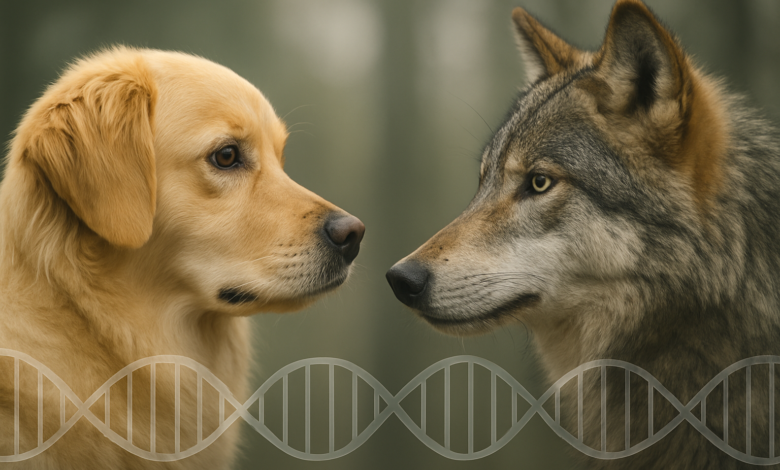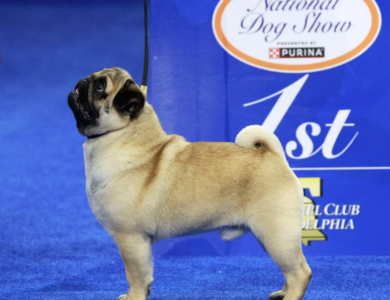We may earn a commission when you click on links across our website. This does not influence our opinions — learn more.
Genetic Bombshell Shows Dogs Carry Far More Wolf Ancestry Than Anyone Realised

The adorable lap dog curled at your feet may be far more wild than you ever imagined.
New U.S. research released on November 24, 2025, has uncovered a startling genetic reality: nearly two-thirds of modern dog breeds still carry faint but measurable traces of wolf DNA, revealing a deeper and more persistent link between wolves and domestic dogs than scientists previously believed.
The findings don’t suggest wolves are currently mingling with neighborhood pets, experts emphasize, but do challenge the long-held view that domestication created a clean break between species.
The Research Behind the Discovery
The study, published in the Proceedings of the National Academy of Sciences, is one of the largest genetic analyses ever conducted on dogs.
Led by Audrey Lin of the American Museum of Natural History and Logan Kistler of the Smithsonian Museum of Natural History, researchers examined more than 2,600 dog and wolf genomes — some dating back nearly 100,000 years.
The genetic archive included ancient wolves, early domestic dogs, modern purebreds, and hundreds of free-roaming village dogs that live alongside humans across the globe.
By analyzing nuclear DNA, mitochondrial DNA, and Y-chromosome markers, scientists traced a surprising amount of genetic overlap across species.
The key finding: 64.1% of today’s dog breeds carry wolf ancestry from interbreeding events that took place roughly 800 to 1,000 generations ago, long after dogs first diverged from wolves.
While the average percentage is tiny — just 0.14% — its presence alone overturns decades of assumptions about “pure” breed genetics.
How Much Wolf DNA Do Breeds Carry?
Some breeds stood out immediately. Czechoslovakian and Saarloos wolfdogs unsurprisingly top the list, containing as much as 40% wolf DNA, a result of intentional cross-breeding during their creation.
More unexpectedly, the Grand Anglo-Francais Tricolore hound carries around 5%, making it the “wolfiest” traditional pet breed.
Hunting breeds such as Salukis and Afghans also ranked high, their genetic profiles reflecting ancient lineage ties to wild canids.
At the opposite end of the spectrum, breeds like the Saint Bernard showed no detectable wolf DNA despite their imposing size.
Even tiny dogs, however, weren’t entirely exempt. Chihuahuas carry approximately 0.2% wolf DNA — a fact Lin called both scientifically significant and unsurprising to anyone who has lived with one.
The broader pattern reveals striking differences across breed categories.
Arctic sled dogs, pariah breeds, and traditional hunting dogs carried the highest levels, while terriers, scent hounds, and gundogs had the lowest.
Large working and guardian breeds fell somewhere in the middle.
Why Village Dogs Matter Most
The most revealing clues came not from purebreds but from village dogs — the 300 to 400 million free-roaming dogs that live near human settlements worldwide.
Researchers found that 100% of village dogs sampled carried wolf DNA, making them the most genetically intertwined canine populations on the planet.
Their lifestyle may explain why.
illage dogs have more opportunities for contact with wolves, and displaced female wolves separated from packs by habitat loss or human interference may have occasionally bred with stray males.
Over centuries, these rare events seeded wolf DNA into the broader dog population, where tiny fragments persisted through countless generations.
Remarkably, wolf genetic segments found in village dogs often involved olfactory receptor genes.
Researchers believe these wolf-derived scent traits helped free-roaming dogs adapt to unpredictable environments, where superior smell could offer vital survival advantages.
How Did Interbreeding Happen?
While wolves and dogs don’t commonly interbreed today, historical encounters appear to have been frequent enough to leave permanent genetic marks.
A single wolf-dog hybrid, for example, carries 50% wolf DNA; if it mated with fully domestic dogs, its descendants would retain smaller but persistent traces.
After hundreds of generations, only faint fragments remain — but those fragments are detectable.
These findings dispute the belief that domestication separated wolves and dogs into completely distinct lineages.
Instead, the data suggests a long and complex evolutionary relationship shaped by human expansion, habitat disruption, and the varied lifestyles of dogs across different regions.
Does Wolf DNA Affect Your Dog’s Traits?
The presence of wolf DNA raises inevitable questions about behaviour and physical traits, but scientists are cautious. While some patterns emerged, none are absolute.
Breeds with larger amounts of wolf DNA were more likely to be described as dignified, territorial, or independent, whereas breeds with little or none were often labelled friendly, easy to train, and affectionate.
However, traits such as intelligence, obedience, and calm temperaments appeared across both groups.
Researchers emphasized that environment, training, and individual temperament remain far more important predictors of behaviour than ancient genetic fragments.
Physically, dogs with higher wolf ancestry tended to be larger, though exceptions like the wolf-free Saint Bernard highlight how selective breeding can override these influences.
Some wolf genes appear to confer specific advantages.
Tibetan breeds such as the Lhasa Apso, for instance, carry a wolf-derived gene called EPAS1 that helps them thrive at high altitudes.
Village dogs benefit from enhanced olfactory genes inherited from wolves, supporting survival in unstable landscapes.
What This Discovery Does Not Mean
Scientists are urging the public not to misinterpret the findings.
The presence of wolf DNA does not suggest that wolves are currently breeding with household pets, nor does it imply that dogs with higher wolf ancestry are dangerous or reverting to wild behaviour.
Instead, the research highlights a long history of sporadic interbreeding shaped by thousands of years of coexistence.
Importantly, the study challenges the idea that dog genomes can only sustain minuscule amounts of wolf DNA.
Instead, researchers found that the canine genome is far more flexible than previously assumed, capable of incorporating wolf traits while still producing the domestic companions we know today.
Conservation and Future Research
The findings also carry major implications for wolf conservation.
In regions such as Europe and Asia, hybridization between dogs and endangered wolf populations can dilute fragile gene pools.
Yet in some cases, dog-derived genes may help wolves adapt to shrinking habitats or increased human contact.
For researchers, the study opens a host of new questions. How much wolf ancestry can dogs carry before hybrids become genetically incompatible? Why do some breeds retain ancient wolf segments while others purge them entirely? And how do these tiny fragments interact with the traits humans have selectively bred into dogs over millennia?
This groundbreaking research reshapes the story of canine evolution.
Rather than representing a sharp divide from their wild ancestors, domestic dogs appear to have maintained a faint but persistent genetic thread connecting them to wolves.
Whether it’s the Chihuahua on your sofa or the husky pulling a sled across the Arctic, nearly two-thirds of modern dog breeds carry an ancient echo of the wild.



